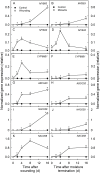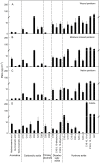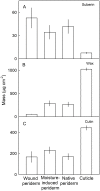Apple fruit periderms (russeting) induced by wounding or by moisture have the same histologies, chemistries and gene expressions
- PMID: 36174078
- PMCID: PMC9522254
- DOI: 10.1371/journal.pone.0274733
Apple fruit periderms (russeting) induced by wounding or by moisture have the same histologies, chemistries and gene expressions
Abstract
Russeting is a cosmetic defect of some fruit skins. Russeting (botanically: induction of periderm formation) can result from various environmental factors including wounding and surface moisture. The objective was to compare periderms resulting from wounding with those from exposure to moisture in developing apple fruit. Wounding or moisture exposure both resulted in cuticular microcracking. Cross-sections revealed suberized hypodermal cell walls by 4 d, and the start of periderm formation by 8 d after wounding or moisture treatment. The expression of selected target genes was similar in wound and moisture induced periderms. Transcription factors involved in the regulation of suberin (MYB93) and lignin (MYB42) synthesis, genes involved in the synthesis (CYP86B1) and the transport (ABCG20) of suberin monomers and two uncharacterized transcription factors (NAC038 and NAC058) were all upregulated in induced periderm samples. Genes involved in cutin (GPAT6, SHN3) and wax synthesis (KCS10, WSD1, CER6) and transport of cutin monomers and wax components (ABCG11) were all downregulated. Levels of typical suberin monomers (ω-hydroxy-C20, -C22 and -C24 acids) and total suberin were high in the periderms, but low in the cuticle. Periderms were induced only when wounding occurred during early fruit development (32 and 66 days after full bloom (DAFB)) but not later (93 DAFB). Wound and moisture induced periderms are very similar morphologically, histologically, compositionally and molecularly.
Conflict of interest statement
The authors have declared that no competing interests exist.
Figures









References
-
- Evert RF. Periderm. In: Evert RF, editor. Esau’s Plant Anatomy: Meristems, Cells, and Tissues of the Plant Body—Their Structure, Function, and Development. Hoboken: John Wiley & Sons Inc.; 2006, pp. 427–446.
-
- Easterbrook MA, Fuller MM. Russeting of apples caused by apple rust mite Aculus schlechtendali (Acarina: Eriophyidae). Ann Appl Biol. 1986; 109:1–9. doi: 10.1111/j.1744-7348.1986.tb03178.x - DOI
-
- Simons RK, Aubertin M. Development of epidermal, hypodermal and cortical tissues in the Golden Delicious apple as influenced by induced mechanical injury. Proc Amer Soc Hort Sci. 1959; 74:1–9.
-
- Goffinet MC, Pearson RC. Anatomy of russeting induced in Concord grape berries by the fungicide Chlorothalonil. Amer J Enol Vitic. 1991; 42:281–289.
Publication types
MeSH terms
Substances
LinkOut - more resources
Full Text Sources

